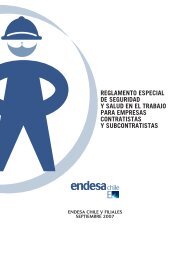Introducción al Cálculo de Caudales Ecológicos - Endesa..
Introducción al Cálculo de Caudales Ecológicos - Endesa..
Introducción al Cálculo de Caudales Ecológicos - Endesa..
You also want an ePaper? Increase the reach of your titles
YUMPU automatically turns print PDFs into web optimized ePapers that Google loves.
Low risk<br />
and high<br />
baseflow<br />
Low risk<br />
and low<br />
baseflow<br />
Risk of <strong>de</strong>leterious effect<br />
Mo<strong>de</strong>rate<br />
risk and<br />
high baseflow<br />
Mo<strong>de</strong>rate<br />
risk and<br />
low baseflow<br />
High risk<br />
and high<br />
baseflow<br />
Tabla B8<br />
Relación entre el grado <strong>de</strong> <strong>al</strong>teración hidrológica y el tot<strong>al</strong> <strong>de</strong> extracción expresado como % <strong>de</strong>l caud<strong>al</strong> medio anu<strong>al</strong> para varias clasificaciones<br />
<strong>de</strong> riesgo, basada en el tamaño <strong>de</strong>l cauce y la composición <strong>de</strong> especies.<br />
Fuente: Draft gui<strong>de</strong>lines for the selection of methods to <strong>de</strong>termine ecologic<strong>al</strong> flows and water levels.<br />
Tabla B9<br />
Métodos empleados para <strong>de</strong>terminar requerimientos <strong>de</strong> caud<strong>al</strong> ecológico según grados <strong>de</strong> <strong>al</strong>teración hidrológica y significancia para<br />
cursos <strong>de</strong> agua.<br />
Fuente: Draft gui<strong>de</strong>lines for the selection of methods to <strong>de</strong>termine ecologic<strong>al</strong> flows and water levels.<br />
High risk<br />
and low<br />
baseflow<br />
Degree of<br />
hydrologic<strong>al</strong><br />
<strong>al</strong>teration<br />
20% High<br />
Degree of<br />
hydrologic<strong>al</strong><br />
<strong>al</strong>teration<br />
Low Historic<strong>al</strong> flow method<br />
Expert panel<br />
Medium Historic<strong>al</strong> flow method<br />
Expert panel Gener<strong>al</strong>ised<br />
habitat mo<strong>de</strong>ls<br />
High Gener<strong>al</strong>ised habitat mo<strong>de</strong>ls<br />
1D Hydraulic habitat mo<strong>de</strong>l<br />
Connectivity/fish passage<br />
Periphyton biomass mo<strong>de</strong>l<br />
Nombre <strong>de</strong>l<br />
Proyecto<br />
Fuente: Jamett 2005.<br />
INTRODUCCIÓN AL CÁLCULO DE CAUDALES ECOLÓGICOS / Un análisis <strong>de</strong> las ten<strong>de</strong>ncias actu<strong>al</strong>es<br />
Significance of instream v<strong>al</strong>ues<br />
Low Medium High<br />
Región<br />
<strong>de</strong> Chile<br />
Año <strong>de</strong><br />
ingreso<br />
<strong>al</strong> SEIA<br />
Historic<strong>al</strong> flow method Expert<br />
panel<br />
Gener<strong>al</strong>ised habitat mo<strong>de</strong>ls<br />
1D hydraulic habitat mo<strong>de</strong>l<br />
Connectivity/fish passage<br />
Entrainment mo<strong>de</strong>l 1D Hydraulic<br />
habitat mo<strong>de</strong>l 2D Hydraulic<br />
habitat mo<strong>de</strong>l Bank stability<br />
Dissolved oxygen mo<strong>de</strong>l<br />
Temperature mo<strong>de</strong>ls Suspen<strong>de</strong>d<br />
sediment Fish bioenergetics<br />
mo<strong>de</strong>l Inundation mo<strong>de</strong>lling<br />
Groundwater mo<strong>de</strong>l Seston<br />
flux Connectivity/fish passage<br />
Periphyton biomass mo<strong>de</strong>l<br />
Gener<strong>al</strong>ised habitat mo<strong>de</strong>ls<br />
1D hydraulic habitat mo<strong>de</strong>l<br />
Connectivity/fish passage Flow<br />
duration an<strong>al</strong>ysis<br />
1D hydraulic habitat mo<strong>de</strong>l 2D<br />
hydraulic habitat mo<strong>de</strong>l Dissolved<br />
oxygen mo<strong>de</strong>l Temperature<br />
mo<strong>de</strong>ls Suspen<strong>de</strong>d sediment Fish<br />
bioenergetics mo<strong>de</strong>l Groundwater<br />
mo<strong>de</strong>l Seston flux Connectivity/fish<br />
passage Flow variability an<strong>al</strong>ysis<br />
Entrainment mo<strong>de</strong>l 1D Hydraulic<br />
habitat mo<strong>de</strong>l 2D Hydraulic habitat<br />
mo<strong>de</strong>l Bank stability Dissolved<br />
oxygen mo<strong>de</strong>l Temperature<br />
mo<strong>de</strong>ls Suspen<strong>de</strong>d sediment Fish<br />
bioenergetics mo<strong>de</strong>l Inundation<br />
mo<strong>de</strong>lling Groundwater mo<strong>de</strong>l<br />
Seston flux Connectivity/fish<br />
passage Periphyton biomass mo<strong>de</strong>l<br />
Flow variabiity an<strong>al</strong>ysis<br />
Tipo <strong>de</strong> método Forma <strong>de</strong> <strong>de</strong>terminación <strong>de</strong> un caud<strong>al</strong><br />
ecológico (Q e<br />
Emb<strong>al</strong>se Illapel IV 1999 Hidrológico simple Qe = X (Q * 0,7)<br />
mensu<strong>al</strong><br />
Emb<strong>al</strong>se Corr<strong>al</strong>es IV 1998 Hidrológico simple Qe = 0.2 * Q mensu<strong>al</strong> míni modiariomensu<strong>al</strong><br />
Convento Viejo<br />
Etapa II<br />
VI 2004<br />
Hidrológico simple<br />
(Tennat)<br />
Qe = CAM10%<br />
Proyecto<br />
Hidroeléctrico La<br />
VI 2004 Hidrológico simple<br />
Qe = 10%CAM corregido por<br />
estacion<strong>al</strong><br />
resultados aplicando Ley francesa y Norma<br />
Higuera<br />
suiza<br />
Centr<strong>al</strong> Hidroeléctrica<br />
Quilleco<br />
VIII 1998 Simulación <strong>de</strong> hábitat Qe según método IFIM<br />
Centr<strong>al</strong> Hidroeléctrica<br />
Lago Atravesado<br />
Tabla B10<br />
XI 1998 Hidrológico simple<br />
Qe según análisis estadísticos simples sobre<br />
caud<strong>al</strong>es observados <strong>de</strong> 1979 a 1997<br />
Métodos utilizados para <strong>de</strong>terminar un caud<strong>al</strong> ecológico por proyectos ingresados <strong>al</strong> SEIA hasta el año 2004.<br />
49



